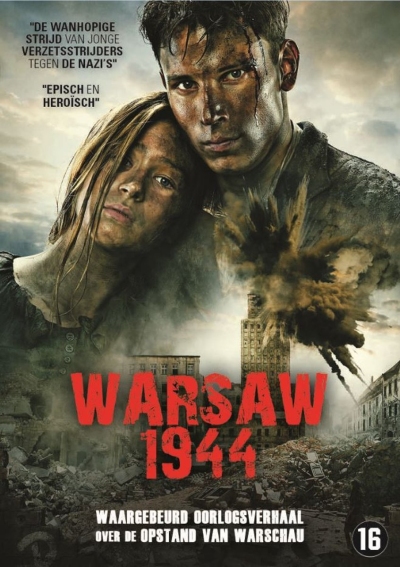| Title: | Warsaw 1944 |
| Director: | Jan Komasa |
| Cast: | Józef Pawlowski, Anne Próchniak, Antoni Królikowski a.o. |
| Released: | 2014, on DVD in 2015 |
| Publisher: | Three Line Pictures |
| Playtime: | 121 minutes |
| Description: | In the summer of 1944, it seemed as if the end of the Nazi occupation in Warsaw was near. The Red Army was across the Vistula River, seemingly preparing for the capture of the Polish capital. While Paris was liberated by the Allies on August 25, the Poles fought in Warsaw to also expel the occupier from their city. Their struggle for freedom began on 1 August with good spirits, but ended on 2 October in a German victory. The Polish struggle for independence was smothered with a lot of bloodshed. In addition to more than 15,000 dead and missing among the resistance fighters, regrettably more than 150,000 fatalities were found among the civilian population. When the Red Army finally crossed the Vistula on January 17, 1945, it found a ghost town laid in ruins. The Polish feature film, "Warsaw 1944" by director Jan Komasa, takes place during the uprising in the Polish capital. Stefan Zawadzki and his friends, all less than 20 years old, enthusiastically join the fight declared by the Polish resistance army Armia Krajowa. Youthful recklessness is their most important weapon, because they lack experience, military discipline and real weapons. The boys and girls soon celebrate an exuberant liberation party when part of the city has fallen into the hands of the resistance. However, the German counterattack is ruthless. Nothing and nobody is spared. Anyone who can contribute anything to the fight is deployed by the Polish resistance. Young women nurse the wounded and little boys act as messengers or lookouts. Stefan first has to manage without a weapon, but wants to contribute at all costs and kill Germans. His group of friends is hit hard by the enemy. War turns out to be anything but child's play. Friendship and childhood sweethearts play a role in the story, but are overshadowed by the harsh reality of the uprising. Young freedom fighters die by the dozens and the civilian population is completely isolated from the outside world and in the hell their city has turned into. The viewer is not spared the horrors of war. While it rains blood and body parts in one scene, we see in another fragment how a grenade causes a bloodbath in a basement full of frightened citizens, including a mother with her crying baby. As a viewer, you could be dulled by all the violence, were it not for the fact that it was dosed in such a way that there was enough room to live with the main characters. They see the most terrible things happening before them. The struggle for freedom gradually changes into a desperate fight for survival. Their fellow sufferers make the cold facts tangible: in Warsaw an entire generation was all but exterminated. It is not a positive message, but sentimentalism does not fit with an unimaginable tragedy like this. While the Second World War is increasingly further away from today's youth, a hardy war film like this is not superfluous. These days we like to nuance and colour what is black in grey or white, but irrefutably black pages in history, such as the Warsaw Uprising, cannot be watered down. A confronting film like this is not intended to resurrect hostilities against the Germans, but shows the war in its true form, to a generation that knows only freedom and European integration. In bustling Warsaw of the twenty-first century, there is nothing left of the smouldering ruins in which the city was changed in 1945. In the final scene of the film we see how the view of the burning, destroyed city changes into the colourfully illuminated skyline of modern Warsaw. "Warsaw 1944" still ends in a positive way, though you have had to wait breathlessly for that. |
| Rating: |     (Very good) (Very good) |
Information
- Translated by:
- Fernando Lynch
- Article by:
- Kevin Prenger
- Published on:
- 13-04-2019
Images
 Warsaw 1944
Warsaw 1944

